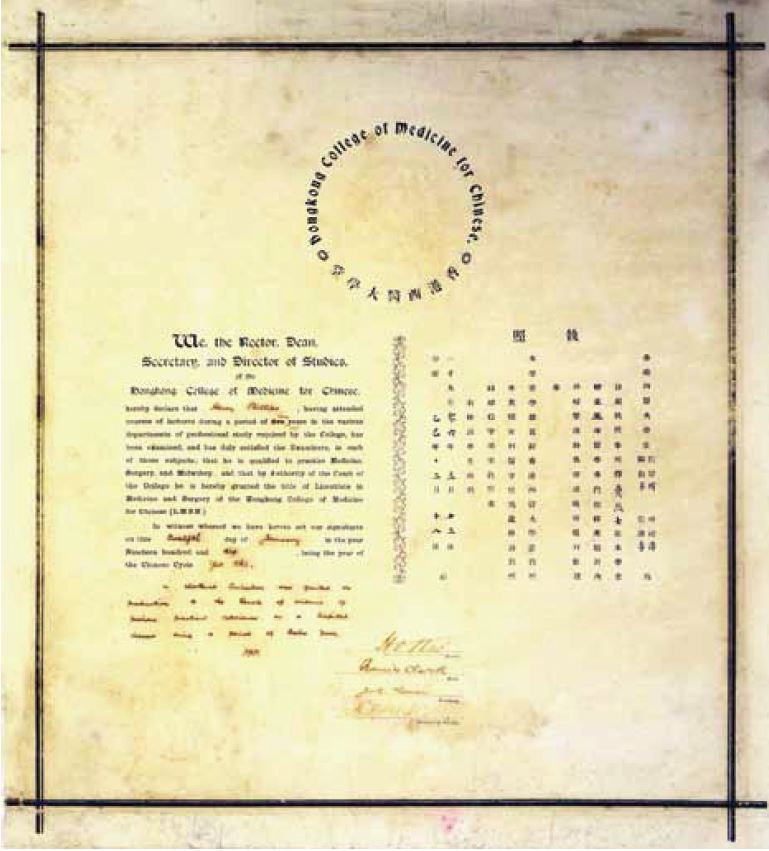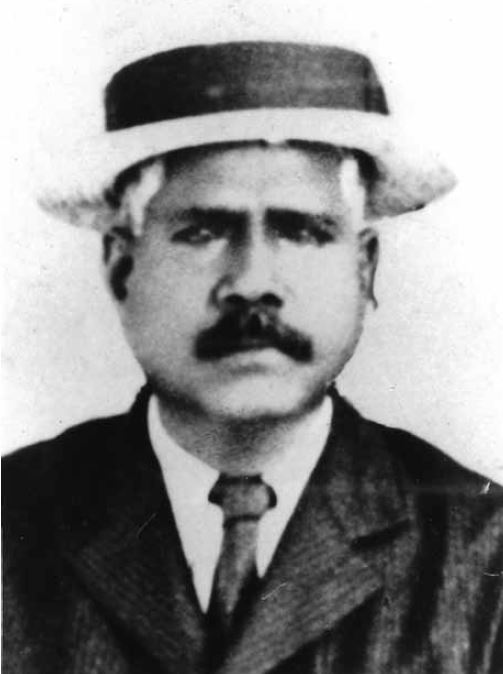© Hong Kong Academy of Medicine. CC BY-NC-ND 4.0
REMINISCENCE: ARTEFACTS FROM THE HONG KONG MUSEUM OF
MEDICAL SCIENCES
Dr Henry Phillips’ graduation certificate from the Hong
Kong College of Medicine for Chinese, 1906
Faith CS Ho, MD, FHKAM (Pathology)
Education and Research Committee, Hong Kong Museum
of Medical Sciences Society
Unknown to many, of the 128 students who had
enrolled at the Hong Kong College of Medicine for Chinese there were at
least 19 who came from a foreign country (ie, other than Hong Kong and
China) to study medicine in Hong Kong.1
Dr Henry Phillips (1867-1918), whose certificate is featured in this
article, was one of these 19 students. He was born in Jaffna, Ceylon (now
Sri Lanka), and finished his secondary schooling there. He entered the
College in 1903 and was allowed to follow a shortened curriculum of only 3
years, with eligibility for the diploma of the College provided he passed
all his professional examinations.2
This was because he had worked as a medical dresser in a hospital in the
Federated Malay States for 12 years prior to coming to Hong Kong, as was
clearly written on his graduation certificate, dated 1906 (Fig
1). Among the overseas students, 13 came from Asian countries that
were, at that time, part of the British Empire, including Singapore,
Malacca and Penang, forming parts of the Straits Settlements, Burma,
Ceylon, and India. Only one student had come from the Philippines, which
was not part of the empire, and four had come from the United States, all
four of whom were of Chinese descent. It is not surprising to note that
the students all came from countries that were English speaking, since the
course at the College was taught in English.

Figure 1. Original Certificate of Dr Henry Phillips on graduation from the Hong Kong College of Medicine for Chinese, 1906. Donated by his grandson, Dr Mano Arumanayagam to the Hong Kong Museum of Medical Sciences Society in 2000
It may seem something of an anomaly that a person
from Ceylon should seek to enter the College, which was so far from his
home. We do not know what had attracted him to the Malay states to work as
a hospital dresser, but he might have been interested in a medical career
all along. Although a Ceylon Medical College had already been in existence
since 1880 in Colombo, there was no medical school in the Federated Malay
States where he was working. In fact, Phillips was the only person from
Ceylon who came to study at the Hong Kong College of Medicine for Chinese.
When he graduated, the College still had the words ‘for Chinese’ attached
to its name, as shown in his certificate, but a few months later, these
words ‘for Chinese’ were dropped when the College was incorporated. This
was considered more appropriate as there were a growing number of
non-Chinese students entering the College. Thereafter, the College was
known as just the ‘Hong Kong College of Medicine’ (HKCM).
After graduation, Dr Phillips returned to Malaya,
and started his practice as a doctor among the rubber plantations in the
small town of Kuala Kubu Baru in Selangor, about 70 km north of Kuala
Lumpur. Quite a few graduates from the HKCM of this early period had also
found employment in the different parts of the Malay States. The Malay
States did not have a medical school at the time; therefore, the graduates
from the HKCM were highly sought after.
Dr Phillips’ graduation certificate was kindly
donated in 2000 to the Hong Kong Museum of Medical Sciences Society by his
grandson, Dr Mano Arumanayagam, who worked in Hong Kong as an Associate
Professor in the Department of Chemical Pathology at the Chinese
University of Hong Kong. From the information given to the author during
an interview with the donor, Dr Phillips had died at a relatively young
age from cirrhosis of the liver, which was believed to have been due to
over-consumption of alcohol.3 His
widow, who was 20 years younger, then returned to Ceylon with their young
son. Figure 2 shows a photograph of Dr Phillips during
the period when he was practising in Selangor.
The Certificate has been preserved moderately well,
but the circular crest of the HKCM, which was printed in red ink, has
unfortunately been rendered barely visible over time. Fortunately, most of
the words which were hand-written in ink are still legible, and Chinese
characters written with brush and Chinese ink are well preserved. The
design of the certificate is somewhat simpler compared with those of the
earlier period, as it was signed by only four members of the staff of the
HKCM instead of all the teachers and examiners. The signatories are Dr Ho
Kai, who as Deputy Rector was signing on behalf of the Rector, Sir Henry
May; Dr Francis Clark as Dean; Dr John C Thomson as Secretary of the HKCM,
and Dr IE Mitchell as Director of Studies. Dr Mitchell was a medical
missionary working at the Alice Memorial and its affiliated Hospitals at
the time, and therefore supervised the practical work of the students in
the hospitals. The position of ‘secretary’ would be equivalent to the
Registrar nowadays, and the ‘rector’ would be equivalent to the Chairman
of the Presiding Council, the supervisory body.
One interesting aspect of the certificate lies in
the Chinese name used for the HKCM. In other historical documents and
archival records, the name of the HKCM has been translated as 「香港西醫書院」,
and this was also the Chinese name used in the earliest certificates
including that of Kwan King Leung, which is now still well preserved. In
the case of Dr Phillips’ certificate, the words 「香港西醫大學堂」 are used,
indicating an acknowledgement of the status of the HKCM as being
equivalent to that of a university. Indeed, this became the actual state
of affairs 6 years later in 1912, when the HKCM was subsumed into the new
University of Hong Kong as its medical faculty. The words, 「大學堂」 were
commonly applied to Hong Kong’s sole university in its early days and
persisted even after 1963 when the Chinese University of Hong Kong, Hong
Kong’s second university, was established by ordinance.
The Hong Kong Museum of Medical Sciences is
fortunate to have within its collections this original graduation
certificate awarded by the HKCM, as there were only 51 graduates of the
HKCM who were granted the qualification LMSH, ie, Licentiate in Medicine
and Surgery of the Hong Kong College of Medicine (for Chinese). Few other
examples of the original LMSH certificates are known to exist and are
available for public display; they include that of Kwan King Leung (LMSH
1893) now in the possession of the Sun Yat-sen Museum in Hong Kong, and
that of Ho Ko-tsun (LMSH 1901) now in the possession of the University of
Hong Kong Archives. The status of the original certificate of the HKCM’s
most famous graduate, Sun Yat-sen, is not known, although a copy was said
to have graced the entrance lobby of the Anatomy and Physiology Building
of The University of Hong Kong in pre-World War II days.4 The whereabouts of even this copy cannot now be traced.
Through the generosity of Dr Phillips’ family, a replica of this
graduation certificate of Dr Henry Phillips is now on display in the Alice
Ho Miu Ling Charitable Foundation Gallery of the Hong Kong Museum of
Medical Sciences for all to study and enjoy.
1. 羅香林。《國父之大學時代》。增訂臺灣二版。臺北:臺灣商務印書
館;1967:33-42。
2. Minutes of the 59th Meeting of the
Senate of the Hong Kong College of Medicine, from the Registry of the
University of Hong Kong. Now stored in the University Archives.
3. Ho FC. Western Medicine for Chinese: How
the Hong Kong College of Medicine Achieved a Breakthrough. Hong Kong: Hong
Kong University Press; 2017.
4. Ride L. The antecedents. In: Harrison B,
editor. The University of Hong Kong: The First 50 Years, 1911-1961. Hong
Kong: Hong Kong University Press; 1962: 13-4.


